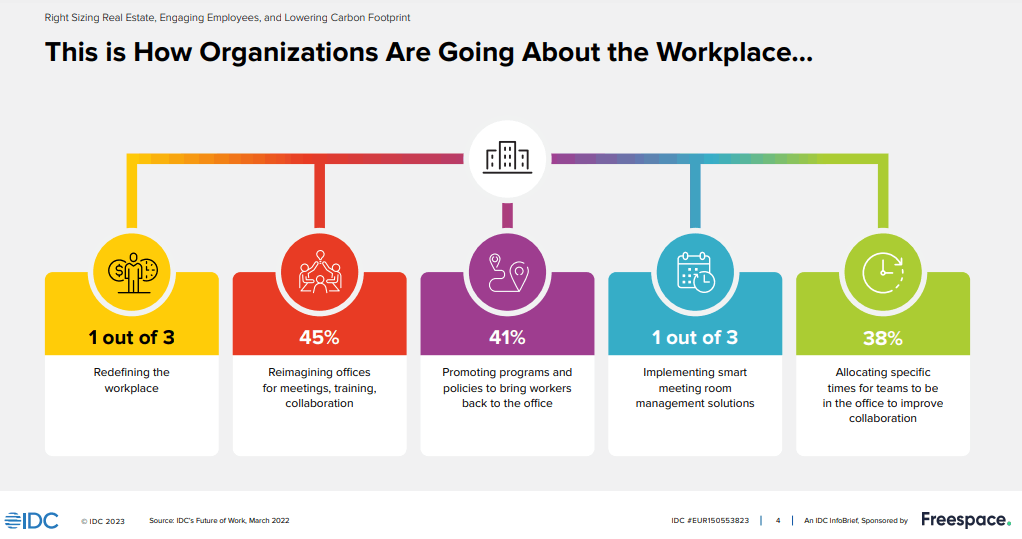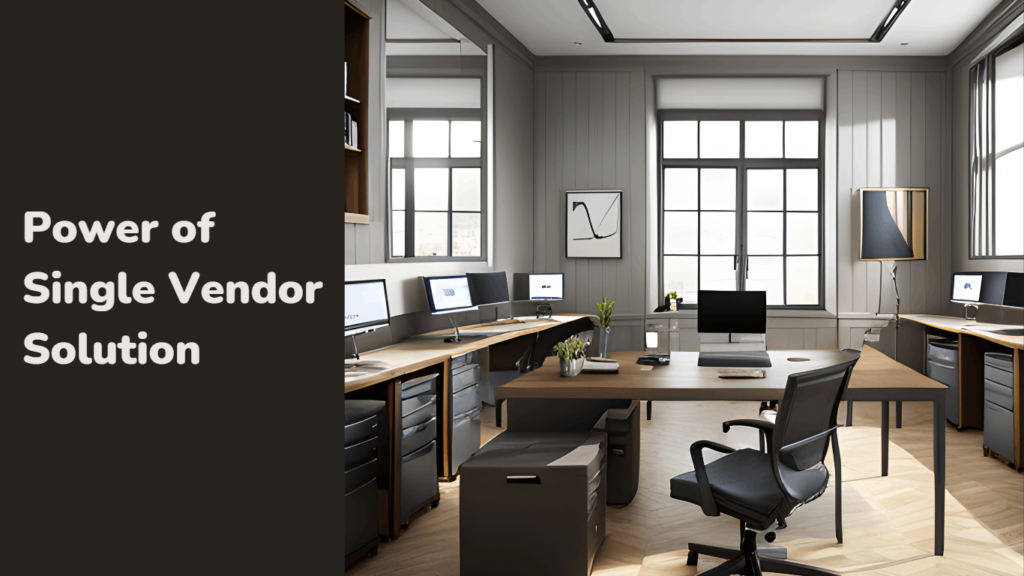

In today’s marketplace, businesses often face the challenge of selecting the right real estate technology solutions to achieve their desired outcomes. JLL’s research reveals that over the next three years, a significant percentage of companies are planning to embrace key technology solutions such as sustainability and environment controls (60%), digital infrastructure and connectivity (58%), and occupancy and environment sensors (56%).
Similarly, according to IDC Info brief Sponsored by Freespace, Right Sizing Real Estate, Engaging Employees, and Lowering Carbon Footprint, Doc #EUR150553823, April (2023), 1 out of 3 organisations are redefining their workplaces. These statistics highlight the growing awareness of the transformative potential of technology in the real estate sector.

But with multiple vendors offering different approaches and functionalities, it can be overwhelming to navigate through the options.
According to a study conducted by EY, 93% of companies have expressed their intention to prioritise investments in the dynamic field of data and analytics. So, in this blog post, we will explore the challenges of a multi-vendor workplace solution and demonstrate how building around a core platform can have significant benefits. We will also discuss the expectations businesses should have from outcome-based solutions.
Challenges of Multivendor Solutions
- Fragmented Implementation:
Multivendor solutions are more complex due to the various vendors involved in implementing different components of a technology stack. This presents specific challenges including increased licensing fees, integration costs; coordination efforts across different vendors that take up valuable time; as well as requiring additional resources and expertise for navigating complexities between multiple vendors.
- Lack of Seamless Integration:
Seamless integration of disparate technologies from multiple vendors is crucial, considering the exponential growth in the number of Software as a Service (SaaS) applications used by organisations worldwide. In just six years, the average number of SaaS applications has skyrocketed by over 1,300%, from 8 in 2015 to 110 in 2022, as per a recent report. With such a diverse technology landscape, various types of integration become essential to equip businesses with advanced capabilities.
However, coordinating these vendors, synchronising data, and ensuring smooth interoperability presents significant challenges. The person overseeing the deployment shoulders the responsibility of managing these complexities, troubleshooting issues, and mitigating potential disruptions before the solution can truly deliver its intended effectiveness.
- Inaccuracy and Maintenance Hassles:
Maintenance in a multivendor environment can be cumbersome. With multiple vendors involved, handoffs between parties become inevitable, which often leads to a lack of accountability. It may require engaging multiple parties and dealing with different support processes, leading to potential delays and increased downtime. These inaccuracies and maintenance hassles can hinder operational efficiency and productivity, as well as add unnecessary costs.
- Limited Record of Vendor Performance:
According to Deloitte, ensuring transparency across all vendors in multi-vendor environments is a significant challenge. Organisations often face constraints due to a lack of monitoring mechanisms and a limited view of vendor performance. Monitoring vendor services is crucial for early identification, communication, and escalation of vendor-related issues. To address this challenge, reliable and continuous measurement instruments are necessary to effectively measure and compare performance against benchmarks and between vendors. Selecting the right indicators to measure service quality across multiple providers is crucial for a uniform and consistent view. Vendor monitoring plays a vital role in continuous service improvement, enabling organisations to enhance their overall performance.
In contrast, a single platform/vendor solution offers a more streamlined and efficient approach to address these drawbacks.
Instead of relying on multiple vendors with their disparate technologies and processes, a unified platform provides a holistic solution that eliminates integration challenges and enhances data accuracy.

Benefits of a Single Platform Solution
With a single vendor platform, businesses can enjoy a seamless and reliable solution that paves the way for improved business outcomes by:
- Rapid Implementation: Eliminate the need for integration and reduce time and resource requirements. With only one point of contact, the entire setup becomes simpler and more efficient.
- Streamlined Integration: The necessity of seamless integration across diverse systems is well understood, emphasising the meticulous crafting of a unified platform ecosystem. Our ecosystem fosters effortless compatibility and simplifies the process of connecting various systems, allowing for smooth integration.
- Streamlined Accountability: Eliminate the complexity of multiple hand-offs and blame games by entrusting accountability to a single vendor, ensuring enhanced reliability and prompt issue resolution.
Freespace as a Single Platform Solution
Freespace provides a comprehensive solution that addresses the challenges faced by businesses seeking outcome-based solutions. Here are the key products Freespace offers (individually or as a complete package.):
- Home-grown, Patented Sensors: Freespace offers a range of workplace sensors designed for different applications including people counting sensors, air quality sensors, occupancy sensors and people flow sensors, allowing for precise monitoring and right sizing of solutions.
- Detailed Analytics: Freespace provides real-time insights, historic analytics, and predictive analysis using a machine learning algorithm (AI-based) spatially and in a timeline format. This comprehensive analysis, coupled with the principles of right sizing and right design, empowers businesses to make informed decisions based on accurate data, optimising their spatial resources for efficiency and effectiveness.
- Fully Integrated Employee App: To ensure a seamless employee experience and empower employees to manage their work week/day effectively, Freespace offers Employee App as a key component of our comprehensive tech stack. This innovative solution, which can be seamlessly integrated into our other offerings, supports every aspect of the employee journey, from finding the right amenities to collaboration and planning your workdays with reservations like meeting rooms, desk spaces, car park, and more.
Choosing the right technology solution for business outcomes is crucial for success. With our focus on large businesses and complex geographical requirements, Freespace is a reliable partner for organisations aiming to achieve their desired outcomes efficiently and effectively.
To find out more – book a demo today.
A single vendor, a unified path to success.


